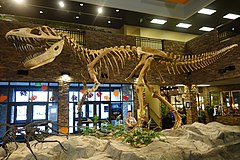| Torvosaurus | |
|---|---|

| |
| Mounted T. tanneri skeletal reconstruction, Museum of Ancient Life | |
| Scientific classification | |
| Domain: | Eukaryota |
| Kingdom: | Animalia |
| Phylum: | Chordata |
| Clade: | Dinosauria |
| Clade: | Saurischia |
| Clade: | Theropoda |
| Family: | †Megalosauridae |
| Subfamily: | †Megalosaurinae |
| Genus: | †Torvosaurus Galton & Jensen, 1979 |
| Type species | |
| †Torvosaurus tanneri Galton & Jensen, 1979
| |
| Other species | |
| |
| Synonyms | |
| |
Torvosaurus (/ˌtɔːrvoʊˈsɔːrəs/) is a genus of large megalosaurine theropod dinosaur that lived approximately 165 to 148 million years ago during the Callovian to Tithonian ages of the late Middle and Late Jurassic period in what is now Colorado, Portugal, Germany, and possibly England, Spain, Tanzania, and Uruguay. It contains two currently recognized species, Torvosaurus tanneri and Torvosaurus gurneyi, plus a third unnamed species from Germany.[1]
In 1979, the type species Torvosaurus tanneri was named. It is a large, heavily built, bipedal carnivore that could grow to a length of about 9 meters (30 ft) and weigh approximately 2–2.4 metric tons (2.2–2.6 short tons). T. tanneri was among the largest terrestrial carnivores of its time, alongside Epanterias and Saurophaganax (which could both be synonymous with Allosaurus). Specimens of Torvosaurus gurneyi were measured up to 10 meters (33 ft) in length and 4–5 metric tons (4.4–5.5 short tons) in body mass,[2] suggesting that it was much larger than T. tanneri and was the largest terrestrial carnivore in Europe during the late Jurassic. Based on bone morphology, Torvosaurus is thought to have had very powerful short arms.
- ^ Cite error: The named reference
:1was invoked but never defined (see the help page). - ^ Hendrickx, C.; Mateus, O. (2014). Evans, Alistair Robert (ed.). "Torvosaurus gurneyi n. sp., the Largest Terrestrial Predator from Europe, and a Proposed Terminology of the Maxilla Anatomy in Nonavian Theropods". PLOS ONE. 9 (3): e88905. Bibcode:2014PLoSO...988905H. doi:10.1371/journal.pone.0088905. PMC 3943790. PMID 24598585.